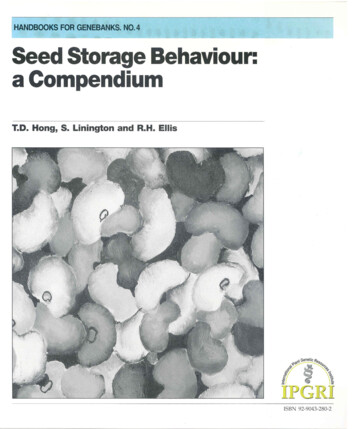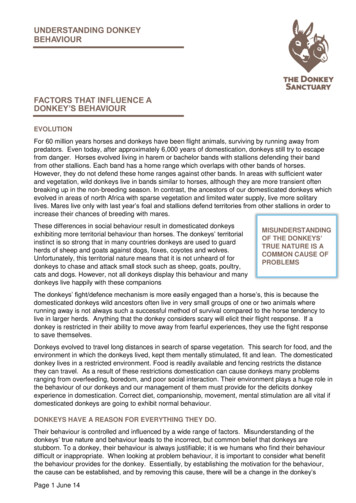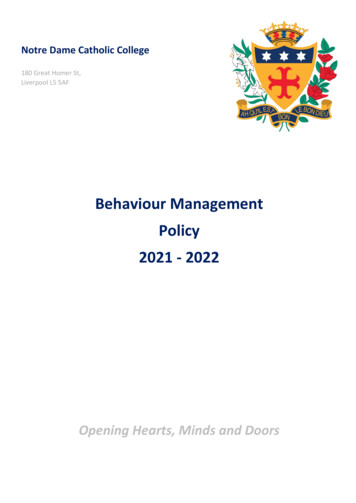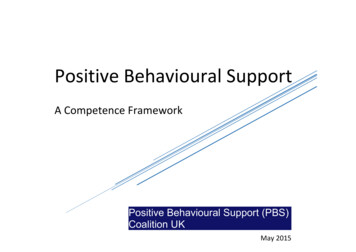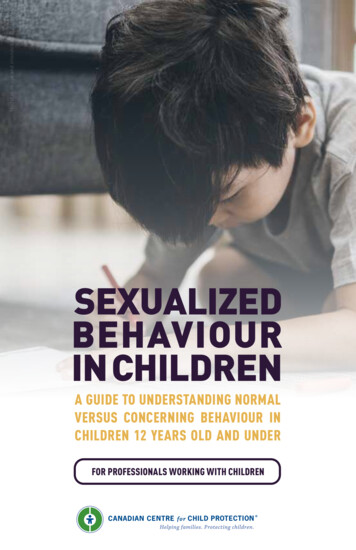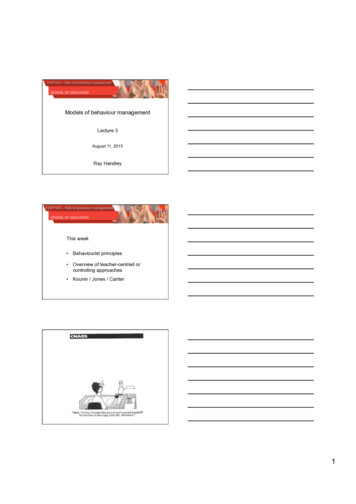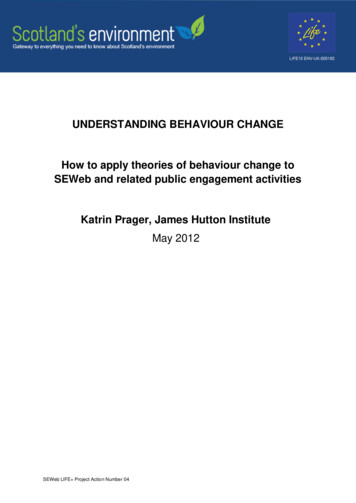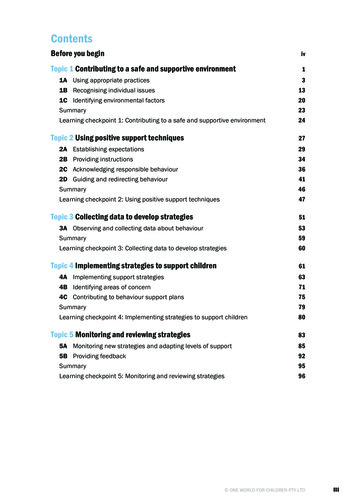
Transcription
ContentsBefore you begin ivTopic 1 Contributing to a safe and supportive environment 11A Using appropriate practices 31B Recognising individual issues 131C Identifying environmental factors 20Summary 23Learning checkpoint 1: Contributing to a safe and supportive environment 24Topic 2 Using positive support techniques 272A Establishing expectations 292B Providing instructions 342C Acknowledging responsible behaviour 362D Guiding and redirecting behaviour 41Summary 46Learning checkpoint 2: Using positive support techniques 47Topic 3 Collecting data to develop strategies 513A Observing and collecting data about behaviour 53Summary 59Learning checkpoint 3: Collecting data to develop strategies 60Topic 4 Implementing strategies to support children 614A Implementing support strategies 634B Identifying areas of concern 714C Contributing to behaviour support plans 75Summary 79Learning checkpoint 4: Implementing strategies to support children 80Topic 5 Monitoring and reviewing strategies 835A Monitoring new strategies and adapting levels of support 855B Providing feedback 92Summary 95Learning checkpoint 5: Monitoring and reviewing strategies 96iii
Topic 1 Contributing to a safe and supportive environmentOut-of-character behaviourOut-of-character behaviour is usually short term;it subsides once the situation is resolved. Thereare many situations that occur in a child’s dailylife that can cause this type of behaviour. Forexample, the child might be:unwellXX tiredXX stressedXX afraidXX frustratedXX angry.XXDisruptive behaviourDisruptive behaviour is when a child is uncooperative and prevents themselves and/or others from focusing on what they are doing. A disruptive child might also grab theeducator’s attention, distracting them from the other children and the task at hand.It is normal for children to exhibit disruptive behaviour as they struggle to learn selfcontrol. Not all disruptive behaviour is of concern, but it should be addressed as partof your regular support to help children develop their social and emotional skills.Disruptive behaviour could take the form of:not following instructionsXX talking loudly or making inappropriate noisesXX leaving the area or wandering aroundXX throwing objectsXX crying; tantrumsXX isolation from peers.XXBehaviours of concernBehaviours of concern, previously called ‘challenging behaviour’, are when a childdoes something that hurts themselves and/or other people.These types of behaviours can prevent children from participating in activities. Theycan harm others and are stressful and upsetting for all involved.Note the following:It is the behaviour that is the problem, not the person.XX These behaviours are not uncommon. Many children behave this way at times.XX Behaviours are only considered ‘of concern’ when they cause a problem to thechild or those around them.XX9
CHCECE006 SUPPORT BEHAVIOUR OF CHILDREN AND YOUNG PEOPLEEmotionaland socialproblemsMany behaviours of concern are linked with mental health insome way. Emotional and social problems can be the cause or theoutcome of a mental health condition.The feelings that children express must be taken seriously. Like allof us, children have good and bad days; sometimes they will needextra support to deal with problems and enjoy their learning andplay.Mental health issues can affect a child’s capacity to:form friendshipsXX resolve conflictXX make decisionsXX learn about other peopleXX develop life skillsXX separate from parents and/or educatorsXX play freelyXX develop confidenceXX deal with angerXX accept behaviour guidance.XXTo read more about mental health issues in childhood, go to theKidsMatter website dTraumaThe word ‘trauma’ describes a deeply distressing or disturbingevent and the emotional shock that follows it. Trauma canseriously affect a child’s mental health and behaviour. Theseverity of trauma is defined by the effect it has on an individual.Trauma may relate to various events, such as grief, loss, war orbeing held in custody.A child who has experienced trauma may show behaviours suchas:difficulty sleeping or disrupted sleep patternsXX loss of appetite or refusal to eatXX regression in developmentXX anxious responses to separations or unfamiliar events,situations or peopleXX social withdrawal or restricted playXX re-enacting an event in play, sometimes repeatedlyXX aggressive behaviour with othersXX fantasising about an eventXX expressing intense emotions inappropriatelyXX flashbacksXX hyperarousal – the child is continually alert and looking fordanger or threats.XX18 ONE WORLD FOR CHILDREN PTY LTD
CHCECE006 SUPPORT BEHAVIOUR OF CHILDREN AND YOUNG PEOPLESeeking adviceIf you identify behaviour of concern, or feel that you need advice in guiding behaviour,there are plenty of people that can help you. Making decisions about a behaviouralsituation is not your responsibility alone. You can seek the support of your supervisor,colleagues and service management, as well as professional organisations. Consultwith these people, particularly if the behavioural issue is concerning.If you need to seek advice from outside your service, it is recommended that youcontact the Inclusion Support Programme (ISP). This program is available to allgovernment-approved suppliers, including long day care, occasional care, family daycare, in-home care, school-age care and vacation care. Remember that before youinvolve an outside body you must gain parental permission. You should make it clearthat you are not only seeking support or assessment for the child. Your main objectiveis to obtain support and advice so that you can meet the child’s needs.Consulting other sourcesConsultation is another way to gather information about a child. Good sources includeparents, educators, specialists that have been involved with the child, and even otherchildren at the service. If you decide to use this strategy, make sure you have parentalpermission before you start.Who32What they can tell you aboutParents orguardiansXXOthereducatorsSpecialistsXXHow to gatherthis informationHome life, including values, culturalpractices, expectations and beliefsXX How the child behaves in variousenvironmentsXX Who the child responds toXX TriggersXX What strategies they useXX What strategies work and don’t workXX What strategies they would not like you touseXXXXTheir observationsXX Their experiences with the family and childXX Out-of-character behaviour, expectedbehaviour and behaviour of concernXX TriggersXX What strategies they have used –successfully or unsuccessfullyXX Their specialist training or experienceXXDiagnosisXX TriggersXX Key featuresXX Links to other developmental areasXX Situations to avoidXX ONE WORLD FOR CHILDREN PTY LTDDiscussionsMeetingsXX SurveysXX FormsXXObservationrecordsXX PortfoliosXX Notes from pastinformationgatheringXX Behaviour plansXX DiscussionsDiscussionsXX AssessmentsXX ReportsXX Meetings
Topic 2 Using positive support techniquesDevelopmental considerationsIf you want your instructions to be understood, you must also keep in mind thechildren’s age and stage of development. Try to consider the guidelines in the followingtable.Age/stageGuidelinesChildrenunder threeGive simple one-step instructions. For example:PreschoolchildrenGive simple two-step instructions. For example:School-agechildrenGive multi-step instructions. For example:‘Put your bag away.’XX ‘Wash your hands.’XX ‘Take your socks off.’XX‘Put your bag away and then come to the mat.’XX ‘Wash your hands and then sit at the table.’XX‘Clear up the bench, then set the table for lunch. After that, gooutside and see what Joe has for us from the garden.’XX ‘First set out your design, then glue it. Once that is done, paintthe surface and let it dry.’XXPractice task 51. What is an instruction you might give to children during a mealtime? Ensure yourinstructions are clear, easy to follow and positive. Include one instruction for eachof the following age groups:a. Two years oldb. Five years oldc. 12 years old2. If the room is noisy, how would you change the way you communicate theseinstructions?35
Topic 2 Using positive support techniquesEncouragementEncouragement shows children that you value them and their efforts, and is a greatway to acknowledge responsible behaviour. Encouragement:motivates the child to do things for intrinsic reasonsXX focuses on the child’s efforts in or process of doing something, not the resultsXX helps the child feel good about what they have done, whichdevelops their self-esteem.XXExampleWatch this video about encouraging and engaging with children.v 0042You should encourage each child’s efforts, whether they succeedor fail. Make sure you are honest and consistent, and that what yousay is sensitive to each child’s needs and matches their level ofunderstanding.Using encouragement to respond to a childKiara, two years old, is trying to help pack up by carrying a big basket of soft toys.Every few steps a toy falls out of the basket. She stops, puts the basket down, puts thetoy back in the basket and sets off again. She does this four times. The fifth time a toyfalls out, she stops, looks at it, then carries the basket to the shelf where it belongs.She then goes back to the toy on the floor, picks it up and takes it to the basket.The educators says to Kiara, ‘Kiara, I can see you are trying very hard. Thank you foryour help.’This type of encouragement acknowledges Kiara’s efforts, but does not require her tofollow a particular process as long as the job gets done.Positive languageIf you want a child to demonstrate positive behaviour, use positive language. Considerthe following two examples. One uses positive language and one does not.SituationWhat the educator saysAn educator sees a child running infrom outside.‘Sean, no running in the room. Youknow that’s not allowed!’An educator sees a child running in thehall at the end of the day.‘Hello, Daisy! You seem in a hurry,remember to walk safely in the hall.’Positive language shows your belief in the child’s abilities and intentions. Youacknowledge that they are capable of doing the right thing, which encourages the childto develop more awareness and self-control.Use your words, tone of voice, facial expressions and body language to communicatecalmness and respect. Try not to make judgments. Keep the focus on the positivebehaviour you want to see, rather than highlighting any negative or inappropriatebehaviour that may be noticeable at the time.37
2DTopic 2 Using positive support techniquesGuiding and redirectingbehaviourGuiding and redirecting the behaviour of childrenis an approach you will use countless timeseach day. Unlike punishment, guidance provideschildren with an appropriate model for behaviourand the necessary information to behaveappropriately the next time.This approach is particularly effective with youngchildren who, lacking words, often communicatethrough their behaviour. Positive supportstrategies can be used to guide and redirect thistype of behaviour and defuse a situation before itgets out of control.The communicative function of behaviourChildren often communicate through their behaviour. These may be positivemessages, but often they take the form of challenging behaviours. When children usechallenging behaviours to communicate, they often do not start off with the purposeof communicating negatively. Their behaviour is usually a reaction, with the child usingthe method they might think of at the time to communicate their needs. This is aperfect example of how children make mistakes as they learn.To identify the message that a child is trying to send, you need to look for the reasonbehind their behaviour – that is, its ‘communicative function’.Communicative functions are commonly divided into two categories. These areoutlined in the following table, which includes examples focused on challengingbehaviours you might notice.CategoryDescriptionExampleRegulationActions used togain, refuse or avoidsomething. The result ofthe behavior is that theenvironment changes.XXThe child is saying:‘I don’t want that.’InteractionActions used to interactwith another person.The result is that theother person takesnotice.The child is saying:‘I want you to listen to ornotice me.’A child pushes another childaway.XX A child throws a cup of milk whenthey want water.XX A child screams when they areoverwhelmed by too many peoplein their space.A child pinches another childwhen they ignore them.XX A child bites when they don’tknow how to enter the play.XX A child tells another child to packup, then pushes the child’s blocktower over to communicate that itis pack-up time.XX41
Topic 2 Using positive support techniquesControlledstrategyDescriptionThis helps a hesitant child to make a choice. Somechildren find it difficult to make decisions. Others have littleexperience in making decisions. These children might feeloverwhelmed by being expected to choose for themselves.You can work through the options with them, give themsome ideas to think about, and in some cases, even suggestthe option you feel is best at the time.Limiting choiceThis helps young children make selections. Young children(especially toddlers) are unable to make big decisions. Youshould provide them with simple options. For example, youmight offer a two-year-old a choice of two options, but a fouryear-old four or five options.ExampleMaking a directsuggestionMaking a direct suggestionSam, four years, has just arrived for the day. His mother has left and Dean, theeducator, asks him what he would like to do today. Sam seems unsure and is lookingaround the room, without making a decision. Dean makes a direct suggestion bysaying, ‘Sam, I know you like building in the block corner, and you like painting too– would you like to do one of those?’ Sam nods and, after a moment’s thought, hemoves off to the block area and settles down to play.ConsequencesConsequences are one of the most effective strategies for helping children to respondappropriately and to change inappropriate behaviour. Consequences help childrento identify and understand the result of their actions. They also give children anopportunity to make a better decision or choice the next time.There are two types of consequences that are commonly used: natural consequencesand logical consequences.Type ofconsequenceNaturalconsequenceDescriptionExampleA natural consequence is when anaction happens and the naturaloutcome is what guides the child.For example:Athalia, four years, says thatshe does not need to put hercoat on to go outside. Whenshe does go out, she becomescold and asks to get her coat.If a child is left to throw sand, itmay hurt other children.XX If a child continues to hurtother children, there may beinjuries and complaints.XX If a child doesn’t wear a hatoutside, they may be sunburnt.XXGetting cold is the naturalconsequence of Athalia’sdecision. By allowing her todecide on her clothing needs,she has learnt that sometimesshe will need her coat.Natural consequences are notalways safe, especially when otherchildren are involved. However,if the natural consequences ofan action are safe, it can be anexcellent way for children to learn.43
Topic 2 Using positive support techniquesLearning checkpoint 2Using positive support techniquesPart AAccess a copy of a behaviour guidance policy, behaviour management policy orresponsible behaviour policy.1. List any specific behaviour guidance strategies identified as inappropriate orunacceptable practice.2. Choose one of the points in the policy that supports your positive guidance ofbehaviour. What does this point say and how does it help you know how to guidebehaviour?Part BRead the case study, then answer the questions that follow.Case studySimon, five years old, is at the bathroom sink. He has been washing his hands for a fewminutes. He accidently drips some water on the floor. He then uses his cupped hands toadd more water and make a puddle, which he spreads across the floor with his foot.The educator asks him to stop playing with the water inside. Simon says, ‘No!’ andcontinues to pour water onto the floor.1. Is the communicative function of Simon’s behaviour aimed at regulation orinteraction?2. What is the desirable result?47
3ATopic 3 Collecting data to develop strategiesObserving and collecting dataabout behaviourThe information you gather from observationaldata will clarify concerns, help you gain a greaterunderstanding of the behavioural situation, andidentify any connected issues. The perspective ofother children is also valuable.Providing evidenceWhen a child is identified as having behaviour ofconcern, it means that you have observed theirbehaviour over a period of time, and it has beenidentified that you and the child need support.Before any action can be taken, the behaviourof concern must be assessed. Collect accurate and unbiased data about the child’sbehaviour that has been gathered over a period of time. This evidence ensures that anappropriate decision can be made about the type of support required.Observational data can be collected in a variety of ways. Somemethods you use may focus only on the observations that arerelevant to the situation. Other methods may be more suited tocapturing the overall contextual picture of a child’s performance anddevelopment. The reason for the data being collected will influencethe collection method you use. For instance, if you are focusing onthe child’s communication and social skills, anecdotal recording maybe suitable; however, if you are looking for specific information formonitoring a behaviour of concern, a tailored checklist may providemore reliable data.Watch this video about collecting observational data.v 0043Collecting observational dataThe following table describes common methods used in education and care services.Many workplaces encourage a combination of these methods to build a holistic view ofthe child’s performance and development.MethodDescriptionAnecdotal recordsAnecdotal data is information not based on formal evidence.Records based on anecdotal evidence are usually basedon observations. As an educator, you must ensure thatthe observations you document are objective, factual andaccurate.Diary entriesDiary entries are regular records of activities and experiences.They are useful for providing contextual information leadingup to an occurrence. As an educator, when looking at diariseddata, you may be able to isolate or identify recurring factorsthat contribute to behaviour or an incident. Diaries, journals,logs and communication books are commonly used to passon information between people.53
Topic 3 Collecting data to develop strategiesPractice task 8Read the case study, then answer the questions that follow.Case studyChild: OttoRecorded by: HarrietAge: 5 yearsEvent: Otto’s behaviourDate: 26.1.18Setting: Indoor playNumber123Time9.35 am10.15 am11.13 amWhat ishappeningjust before thebehaviourWhoelse isinvolvedBuilding acastle butsand is not wetenoughNo oneTrainsetAll childrenwant to playwith Thomasthe TankEngineJim,CelinaandGordonCollageGordon takesthe scissorsthat are nearOtto and Celinatakes the lastpaste brushCelinaandGordonSettingSandpitIntensity ofbehaviour *LowMedDuration ofbehaviourHigh10 minutesX20 minutesX15 minutesX* Low no aggression to others, Med aggressive with environment, High aggressive with other children1. Otto threw a handful of sand, then fell onto the sand. He cried and would not respond to any of theeducators who asked him if he needed help. Otto recovered when Gordon entered the sandpit andbegan to work with the sand.2. Otto bit Jim and threw train carriages at Celina, hitting her in the face. He then threw the train track intothe book corner at other children. Educators Margaret and Harriet tried to calm Otto, but he ran awayfrom them and spat on Margaret. Otto calmed down when Fiona, another educator, asked if he wouldlike a drink of water. He was red-faced and crying.3. Otto grabbed the paste pot and tipped it upside down onto his work. The paste splattered onto thetable and chair, as well as his clothing. Otto reacted to this by jumping up and down and trying to wipethe glue off his top. He then swept the chair away, knocking it over. Then he fell to the floor and cried.Educators attempted to console him, but he would not respond. When Gordon approached the tableand started to paste, Otto stopped crying and watched what he was doing.57
Topic 4In this topic you will learnabout:4A Implementing supportstrategies4B Identifying areas ofconcern4C Contributing tobehaviour support plansImplementing strategiesto support childrenChildren with additional needs, including thosewho exhibit behaviours of concern, often requiresupport strategies. Developing these strategiesrequires reference to information and data that hasbeen collected by educators, and open and honestconsultation with parents, supervisors and otherprofessionals.A support plan is often developed to help all thoseworking with the child to use consistent responses,techniques and methods.61
CHCECE006 SUPPORT BEHAVIOUR OF CHILDREN AND YOUNG PEOPLEThe following table maps this topic to the National Quality Standard and both nationallearning frameworks.National Quality StandardQuality Area 1: Educational program and practiceQuality Area 2: Children’s health and safetyQuality Area 3: Physical environmentQuality Area 4: Staffing arrangements Quality Area 5: Relationships with childrenQuality Area 6: Collaborative partnerships with families and communitiesQuality Area 7: Governance and leadershipEarly Years Learning FrameworkMy Time, Our PlacePrinciples Secure, respectful and reciprocal relationships PartnershipsHigh expectations and equityRespect for diversity Ongoing learning and reflective practicePractice Holistic approachesHolistic approaches Responsiveness to childrenCollaboration with childrenLearning through playLearning through playIntentional teachingIntentionalityLearning environmentsEnvironmentsCultural competenceCultural competenceContinuity of learning and transitionsContinuity and transitionsAssessment for learningEvaluation for wellbeing and learning OutcomesChildren have a strong sense of identityChildren are connected to and contribute to their world Children have a strong sense of wellbeingChildren are confident and involved learners 62Children are effective communicators ONE WORLD FOR CHILDREN PTY LTD
4BTopic 4 Implementing strategies to support childrenIdentifying areas of concernEven the best-laid plans can result in unexpectedoutcomes. When unexpected issues are identified,respond immediately and seek advice to resolvethe issue and reduce the risk to the child.Issues of concern may include:XX unexpected changes in the response of thechild or young personXX signs of distress or illnessXX incidents not addressed by planned strategiesXX lack of progress.Discuss these issues with your supervisor as soon as they are identified.Unexpected changes of responseChildren’s behaviour is generally predictable. For instance, if you smile at an infant,they will usually smile back. If you clap loudly, a child will usually look in your direction.However, you can never be sure how a child will respond to a new strategy as part oftheir behaviour support plan. The child’s response may be positive or negative, or thestrategy may have no discernible effect.The following are examples of positive and negative responses to change.Positive changeresponseYou are implementing a strategy for Wilbur, four years, who spits foodout at mealtimes.Your strategy is to provide him with a platter of foods that he usuallylikes to eat. You will sit next to Wilbur and ask him which food hewould like to eat first. You guide him to think before choosing. Youexpect this strategy to take at least a week to show results, but by thesecond day Wilbur is selecting food items and eating them happily.This positive change response means that you can provide Wilburwith encouragement and positive reinforcement. You can also reviewhis behaviour support plan and introduce new strategies.NegativechangeresponseYou are implementing a strategy for Iman, three years, who haspoor social and verbal communication skills. At the snack table, shepushes other children out of the way and climbs on the table to reachfood when she has an empty plate.Your prescribed strategy is to sit next to Iman at snack time andmodel how to ask other children to pass the fruit platter. When Iman’splate is empty, you ask another child if they could pass the platter toIman. Iman drops her head into her hands and starts to cry. Wailingloudly, she falls to the floor.This is a negative change response and you must support Imanto express her feelings. It also means that you must gather moreinformation about Iman’s behaviour and try to understand what ishappening, and how you can implement a suitable strategy to supporther to interact at mealtimes.71
Topic 4 Implementing strategies to support childrenPractice task 11Read the case study, then answer the questions that follow.Case studyJake, three years, reacts with a tantrum when other children take toys from him. He bangshis head on the floor, holds his breath and screams intermittently. Sometimes the tantrumlasts for up to 30 minutes.1. Choose one practice from the EYLF or MTOP that relates to this case. Explain whyyou think it is important to consider when supporting Jake.2. What training might you need to be able to manage this situation properly?SummaryXXDeveloping a support strategy requires knowledge of the child, the conditions oftheir care and the goals you are aiming to achieve by implementing the strategy.XXThe support strategy must be developed and implemented in consultation withyour supervisor, other educators, specialists (if required) and parents. It is usuallydocumented in a behaviour support plan.XXA consistent approach offers security and predictability. It also allows children toreact in predictable ways.XXChildren with special needs often have the support and guidance of professionalsin child psychology, paediatrics, and access and equity.XXCommon strategies to guide behaviour include role-modelling, choices andconsequences. Other support strategies include tangible rewards, incentive chartsand time out.XXWhen unexpected issues are identified, it is important to respond immediately andseek advice to resolve the issue and reduce the risk to the child.XXIf you are asked to contribute to a behaviour support plan, it is important to meetwith your supervisor to ask questions and clarify your role. To achieve the goals ofany plan you must be provided with clear directions.XXYou may find that some support strategies require complex or specific skills orknowledge. In this case it is appropriate for you to request training.79
Topic 5In this topic you will learnabout:5A Monitoring newstrategies and adaptinglevels of support5B Providing feedbackMonitoring and reviewingstrategiesThe success of a behaviour support plan is affected byadvice from specialists, unexpected responses from thechild, parent requests, and changes in external policiesand guidelines. Monitor the plan for effectiveness,reviewing areas that require adjustment and consultingwith your supervisor to establish new goals asnecessary.83
Topic 5 Monitoring and reviewing strategiesRecording responsesYou can record children’s ideas (or allow them to record the ideas themselves)using:graffiti sheets, noticeboards or comments booksXX profile sheetsXX questionnairesXX interviewsXX suggestion boxesXX surveysXX enrolment formsXX videosXX photos.XXAll of these methods provide children with the opportunity to give you valuableinformation about their needs, and to comment about how they feel about their ownbehaviour and the behaviour of those around them.The success of these methods depends on whatyou are trying to find out – whether the methodsappeal to children and how the methods are used.All methods have advantages and disadvantages,and individuals will prefer one over another.From time to time, a behaviour support plan mayneed to be adapted. Changes may be due to:an unexpected response from the childXX new influences in the play environmentXX new information provided by a parent,specialist or supervisorXX the child’s changing needs (due to normal development or outside factors such ascircumstances at home).XXIn any of these situations, you should consult with your supervisor to determine theoptions available and what changes might need to be made to the existing supportplan.Levels of supportDifferent support techniques are required at different times. A behaviour support planshould allow for this flexibility throughout the observation period. Sometimes the mostdifficult part of developing a plan is identifying:which strategy to prescribe for which behaviourXX what level of support is required.XXThe following table outlines some of the recommended techniques and strategies, andwhen you might implement them. Each child with behaviours of concern requires anindividual approach. Therefore, these are just the basic guidelines.Details about each of these strategies can be found in Topic 2.87
Topic 5 Monitoring and reviewing strategiesStrategyRedirectionand defusingLevel of support whenprescribed in a support planHigh levelXX When used in day-to-dayinteractions, redirection is asimple and general practice(low level)XX When used as a prescribedtechnique, it often helps toavert dangerous situations, orstop learned behaviour before itis out of controlXX If the triggers of the child’sbehaviour are known,redirection can defuse this ifused in a timely mannerXXWhen is it most suitable?When a situation is notproductive.XX When control is an issue.XX When you need to move fromone situation to another.XX When discussion or otherstrategies are not important.XX When you need to stop whatis occurring and you stillhave enough control to divertattention away from a negativebehaviou
toy back in the basket and sets off again. She does this four times. The fifth time a toy falls out, she stops, looks at it, then carries the basket to the shelf where it belongs. She then goes back to the toy on the floor, picks it up and takes it to the basket. The educators says to Kiara, 'Kiara, I can see you are trying very hard. Thank .

